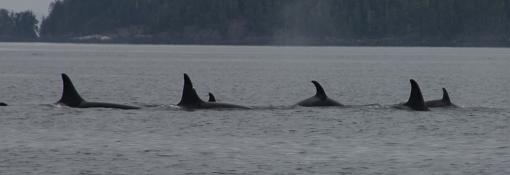I am not sure if this bear was enjoying the beauty of the flowers but it did appear that way. It proceeded to eat some of the grass in the area but not the flowers so maybe there is some hope for wildlife.
We offer an exceptional fly-in lodge for Grizzly Bear Watching and Whale Watching in British Columbia.
Learn about What’s happening at the Lodge, view our British Columbia’s Wildlife Report, read our Grizzly Bear Watching Blog and Whale Watching Blog. Learn more about a Day on the River Blog, see Our Tour Guide’s Photos & Blog and Photos from Our Guests.
The orca pod often viewed on our tours is the A30. A30 matrilineal is the name given to the most commonly seen orca matriline in British Columbia. The matriline was present in over 60% of all of the encounters in the Johnstone Strait region, making it one of best known matrilines. The group’s size has increased, from 6 in the mid-1970s to 10 as of 2013, including 4 calves. It is most frequently seen in Johnstone Strait from late spring to early fall, often traveling with other pods of the Northern Resident Community. The second photo shows this pod minus the three adult males which were in the area but not traveling with the family. Note A72 is the fifth one in the photo.

Even if the above statement is wrong by a thousand times a grizzlies sense of smell is amazing. This bear was checking on a grizzly that had passed an hour earlier but I have also seen them walk along a river in the fall and dig up salmon eggs. Often the river water level will drop exposing gravel bars were salmon had laid their eggs only to be dug up by grizzlies.

Just like that our season has come to an end. I would like to thank all of our wonderful guests and staff who made this year a huge success. I am happy to stay that all of our team is planning to return next season. We are actively taking bookings, with dates starting June 1 2025. Hope to see many of you next season.
The wildlife viewing this season was awesome. A couple highlights that come to mind was the shear number of salmon in our local rivers, as well as the abundance of Resident Orca. With salmon returns being so strong this year, we were happy to see bears in excellent condition. By the end of our season most of the bears had packed on a lot of weight and were getting very “picky” about what parts of the salmon they would eat. Hopefully this will translate into more cubs being born this winter. Another positive was the weather conditions. We had enough rain to keep our fire risks low and it made for some excellent wild berries. The bears took full advantage of this, with the berry season extending far past its normal conclusion. This did mean that we had to work hard to find bears during our summer season, (as they were often feeding on the berries deep into the forest), but moving forward it is excellent that they had such an abundant food supply. The Humpbacks also didn’t disappoint, with great numbers and a few new calves returning with their mothers to feed. After a slower year for resident Orca sightings, this season was one of the best that I can remember. In fact as Im writing this the A62 and A23’s are still being spotted in the area by dedicated biologists. Strong numbers of Chinook and Chum salmon are providing them with a steady food source. There are a lot of positive signs and we are hopeful that 2025 will be another great season.
Over the winter and spring we will be doing some repairs and maintenance. We plan on having a new cedar front deck built in time for the 2025 season, as well as new ceilings and paint in parts of the lodge and rooms. Theres always projects on the go.
Felix, Julien, Ryan, Zack and Myself all look forward to welcoming guest in June. See everyone soon.
Angus Reid
Visit our Blog